
Parys
A lovely little town on the Vaal river first established in 1882. Situated about 100km south-west from Johannesburg. Administratively its part of the Ngwathe municipality which encompasses Edenville, Heilbron, Koppies, Parys and Vredefort. GPS coordinates: 26.9°S 27.456°E elevation: 1400m.
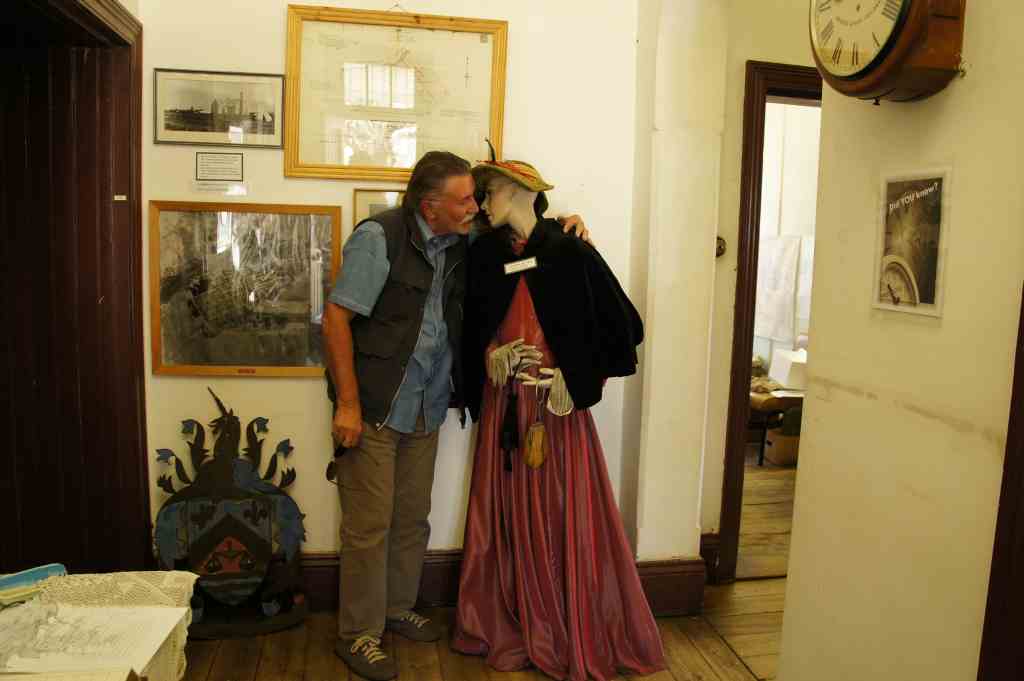 We have been to it on numerous visits, what did we find there? And just to put it into a time slot, those visits were from 2009 to now, and are still continuing.
We have been to it on numerous visits, what did we find there? And just to put it into a time slot, those visits were from 2009 to now, and are still continuing.
One of the attractions are the numerous antique shops which have been coming up over the years, also the art dealers are not far behind now.
Museum
The little museum is well worth a visit. It is housed in the former magistrate's office, erected in 1904. The building has been declared a national monument. It was built in the style of early colonial times in the 20th century.
Exhibits are about the history (human and natural) of the town and its surroundings and the way of life of the people in the earlier days. There are lots of documents, pictures and items of interest on exhibit. And looking at the picture, what else might be going on here?
The museum was opened in 1983 but closed in recent times because of lack of funding. Negotiations are under way to source new funding, this looks promising. The museum can still be visited, but by arrangement only. Iris Andrew is the curator and can be contacted by e-mail at: museuminparys@gmail.com
P.S.: update March 2022, things have changed a bit since then. Iris has moved to the coast. The museum is only open by arrangement, I am on the museum committee and can open up on request, call me on 0833487820. But don't expect a well looked after museum, funding is still a problem, there is no money for renovation.
NG Church
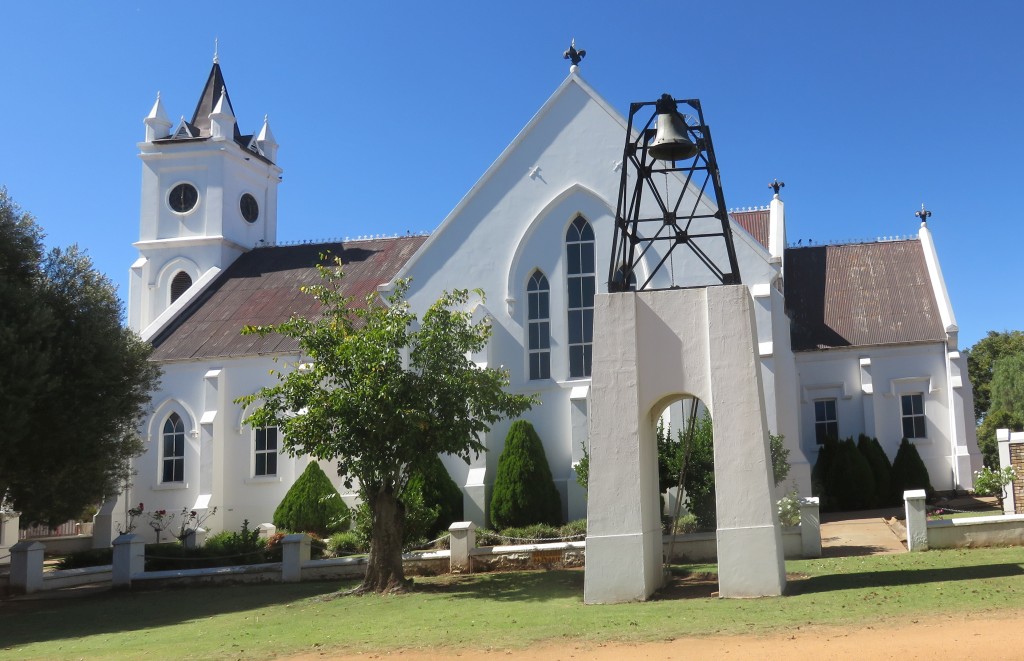
 In the middle of town, unfortunately it is not very visible between all the surrounding houses. It is a beautiful white church building.
In the middle of town, unfortunately it is not very visible between all the surrounding houses. It is a beautiful white church building.
Initially when the town was started the members of the NG church came under the congregation of Heilbron. In 1884 the Parys congregation seceded from the Heilbron church, but it was not until 1890 that they got their own minister, that was T.C.Dönges, who got to work and organised that a provisional church (in the text in Ref 3 referred to as a 'Nootkerk' (emergency church)) was build. 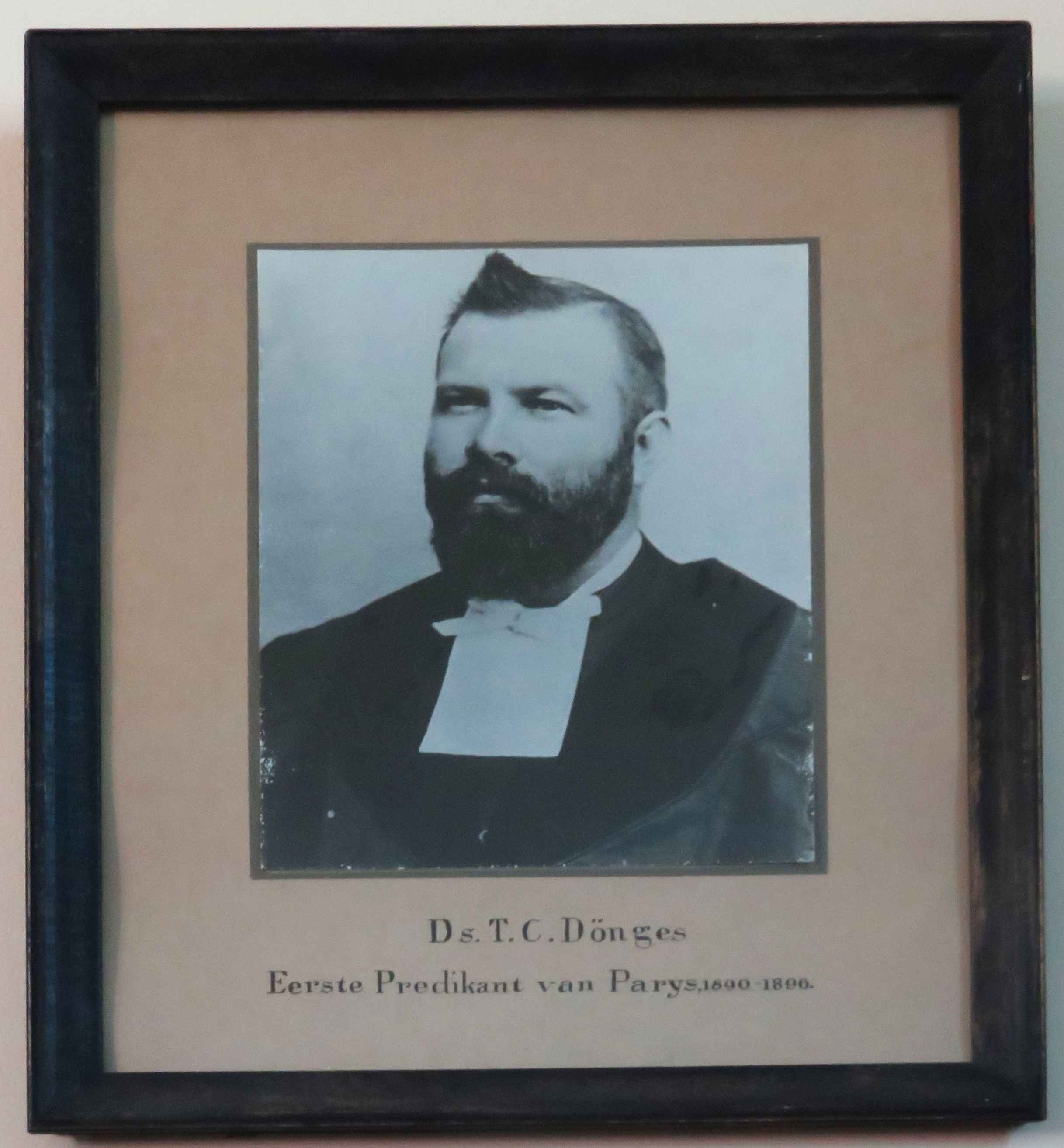 Work on the present church started in 1899 with completion whilst the Boer War was already under way. The inauguration was mainly attended by the woman and children, since the eligible men had all been called to fight in the war. When the British took over the town they used the church as a fort.
Work on the present church started in 1899 with completion whilst the Boer War was already under way. The inauguration was mainly attended by the woman and children, since the eligible men had all been called to fight in the war. When the British took over the town they used the church as a fort.
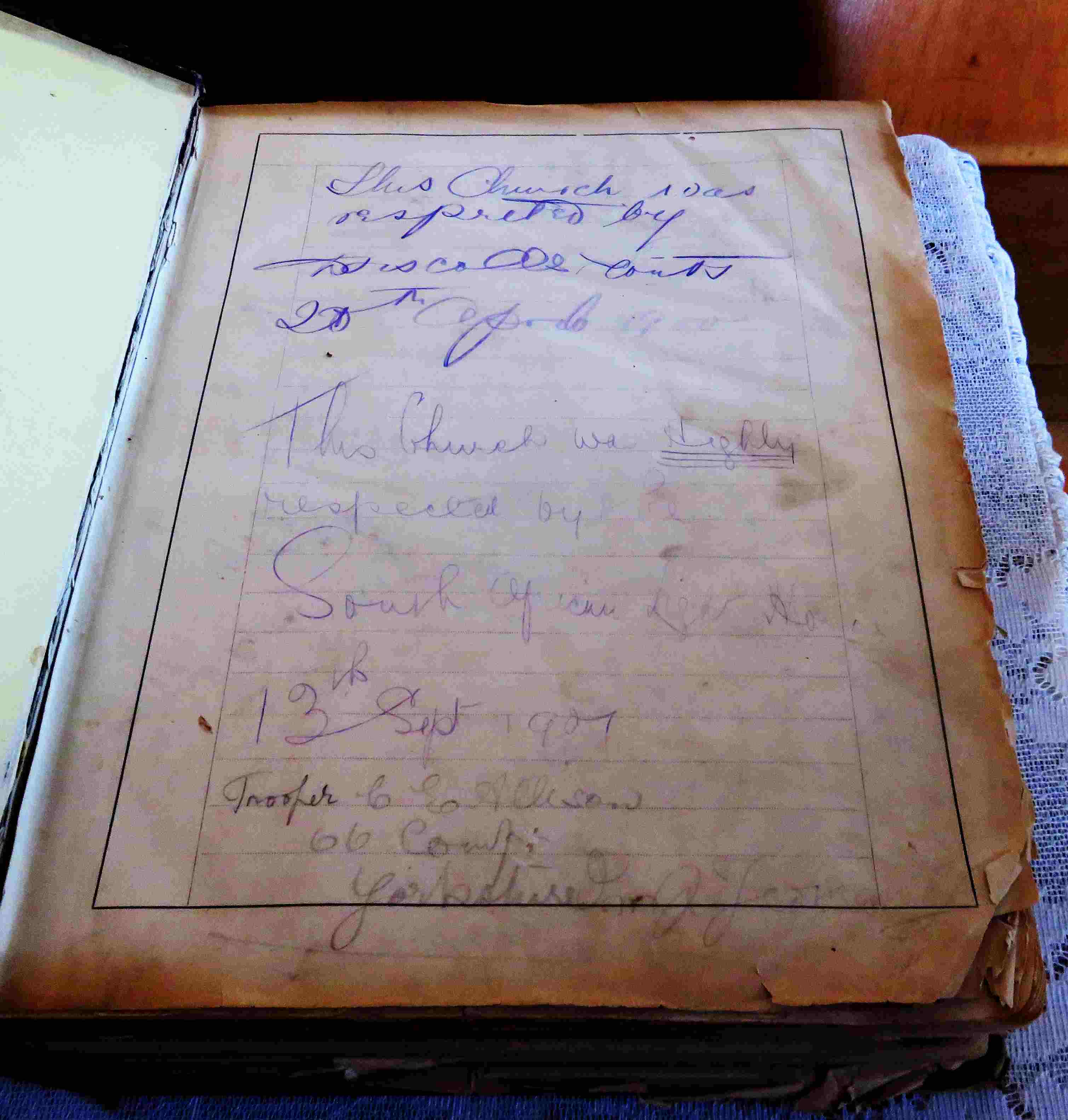 A interesting relic from that time is the bible of the church with some writing of British troops. The script is fading badly but with digital enhancement it can still be read. The first page: "This church was respected by the Driscoll Scouts 20th April. 1900.
A interesting relic from that time is the bible of the church with some writing of British troops. The script is fading badly but with digital enhancement it can still be read. The first page: "This church was respected by the Driscoll Scouts 20th April. 1900.
This church was highly respected by the South African Light Horse. 13th Spetember, 1901.
Trooper C.E.Allison, 66 Company, Yorkshire Imperial Yeomanry."The first entry of 20 April 1900, I find very strange, because Kroonstad to the south of Parys was only taken by the advancing British forces on the 11 May 1900. I would think  that this is a mistake and should be 1901.
that this is a mistake and should be 1901.
The second page only contains a few names: J Bedford 23,030 66th Company Yorkshire ???? Yeom; Jack Stevenson Lancaster. The third page is a mess and not entirely decipherable, here is the picture.
Methodist Church

 The Parys Methodist congregation was first established in 1896. In the time before they built their present church they used a hall in Middle street (opposite the post office) which they shared with the Anglican church.
The Parys Methodist congregation was first established in 1896. In the time before they built their present church they used a hall in Middle street (opposite the post office) which they shared with the Anglican church.
On display in the entrance are the minutes of the meeting held on 13 March 1914, during which the decision was taken to erect a church; The specific section in the minutes reads:  Resolved to build a new church & that the whole committee resolve itself into a building committee, three to constitute a quorum.
Resolved to build a new church & that the whole committee resolve itself into a building committee, three to constitute a quorum.
Proposed that an architect be asked what he will charge for submitting plans & specifications for a church to seat 150 people  with a porch & a 12 foot square vestry to cost about &ound;650.
with a porch & a 12 foot square vestry to cost about &ound;650.
There is no indication of who the architect was. Two foundation stones were laid, one by H O Vos, who was the mayor of Parys at the time, and the other stone was laid by Joseph Grant, I still need to find out who this was. Both stones were laid on 17 Sept 1914.
The church is well decorated with some attractive stained glass windows.
Anglican Church
 It is very difficult to take a good picture of this church, that is because of the palisade fence and the trees. This is the best I could produce. I have no information on when the congregation of the Anglican church was started, I presume similar to the Methodist church at a time before the Anglo Boer war. They shared a hall with the Methodists in Middle street opposite the post office.
It is very difficult to take a good picture of this church, that is because of the palisade fence and the trees. This is the best I could produce. I have no information on when the congregation of the Anglican church was started, I presume similar to the Methodist church at a time before the Anglo Boer war. They shared a hall with the Methodists in Middle street opposite the post office.
The inscription on the corner stone reads: This stone of St Edward's Church was laid by Archdeacon W.H.Weeks on 7th July 1915.' The stones which are referred to as Iron Stones (red granite) were obtained from the old military hospital used during the Anglo Boer. It was situated just out of town towards Sasolburg near the 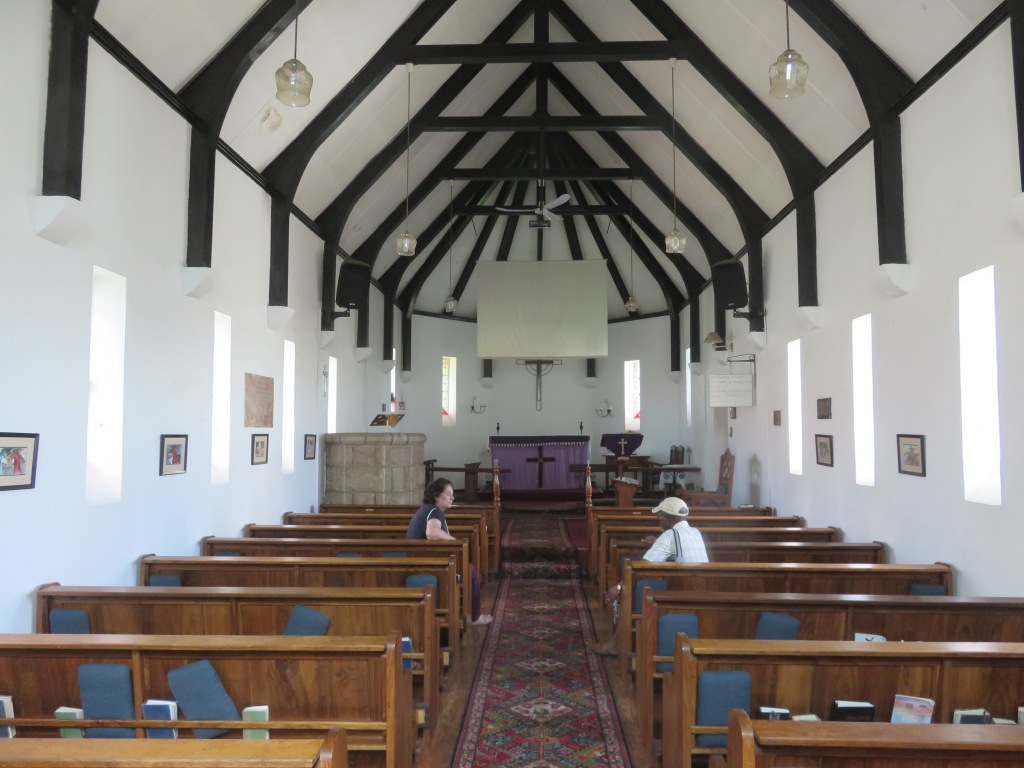 Oudewerfspruit. Dr T.Heaps was in charge of the hospital, he had come to the town from England with the British forces. His future wife was a nurse (some sources say she was the matron) at the hospital, Mrs.Heaps was one of the prominent members of the congregation for many years. When the hospital building was pulled down some years after the war it was through Dr.Heaps' effort that the stones were obtained for building this church. At that time he had become the district surgeon.
Oudewerfspruit. Dr T.Heaps was in charge of the hospital, he had come to the town from England with the British forces. His future wife was a nurse (some sources say she was the matron) at the hospital, Mrs.Heaps was one of the prominent members of the congregation for many years. When the hospital building was pulled down some years after the war it was through Dr.Heaps' effort that the stones were obtained for building this church. At that time he had become the district surgeon.
Inside the church we will find a number of memorial plaques. The one that drew my attention is that of L/CPL Douglas R Sanders 3rd SAI killed in Delville Wood July 15th 1916. It was a well known battle with mainly South African involvement during which they were told to hold the line at any cost, which they did at a very high cost of lives.
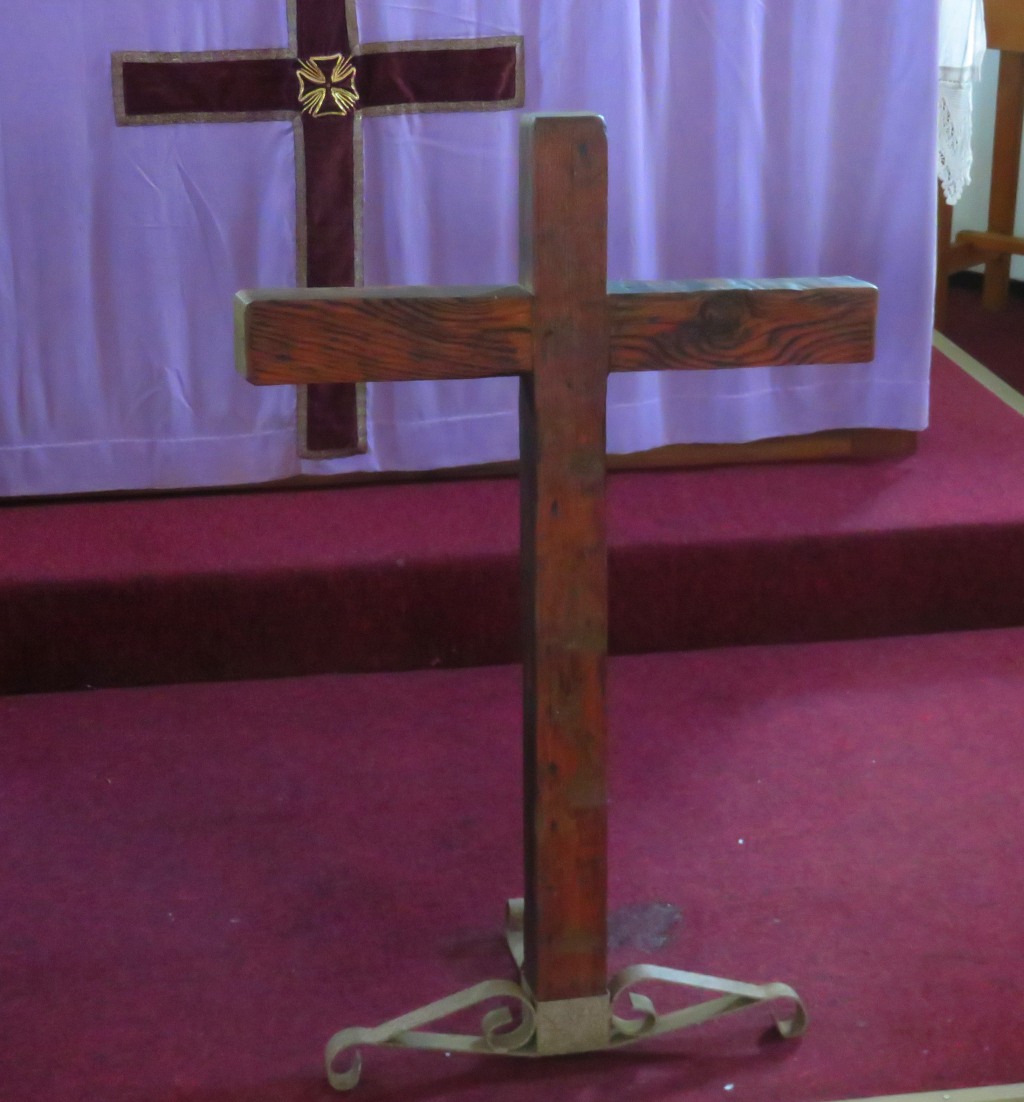
 Another reference to the battle I found in an undated copy of a newspaper article (most likely the Parys Post), an extract reads: Inside the church hangs a cross that was brought by the late Mr.T.C.Fall from Delville Wood where it hung on a wall of a church that had been destroyed by gunfire. Only the one wall was still standing. Mr Fall took shelter behind this wall on which he noticed this cross. He pulled it off before he left this shelter and brought it with him. He presented it to the church before he died in August 1966.
Another reference to the battle I found in an undated copy of a newspaper article (most likely the Parys Post), an extract reads: Inside the church hangs a cross that was brought by the late Mr.T.C.Fall from Delville Wood where it hung on a wall of a church that had been destroyed by gunfire. Only the one wall was still standing. Mr Fall took shelter behind this wall on which he noticed this cross. He pulled it off before he left this shelter and brought it with him. He presented it to the church before he died in August 1966.
I went there and found two crosses which could be the Delville Wood cross, they are not marked. The first cross (on the left} is plain with no features, it stands behind the altar supported on a stand. 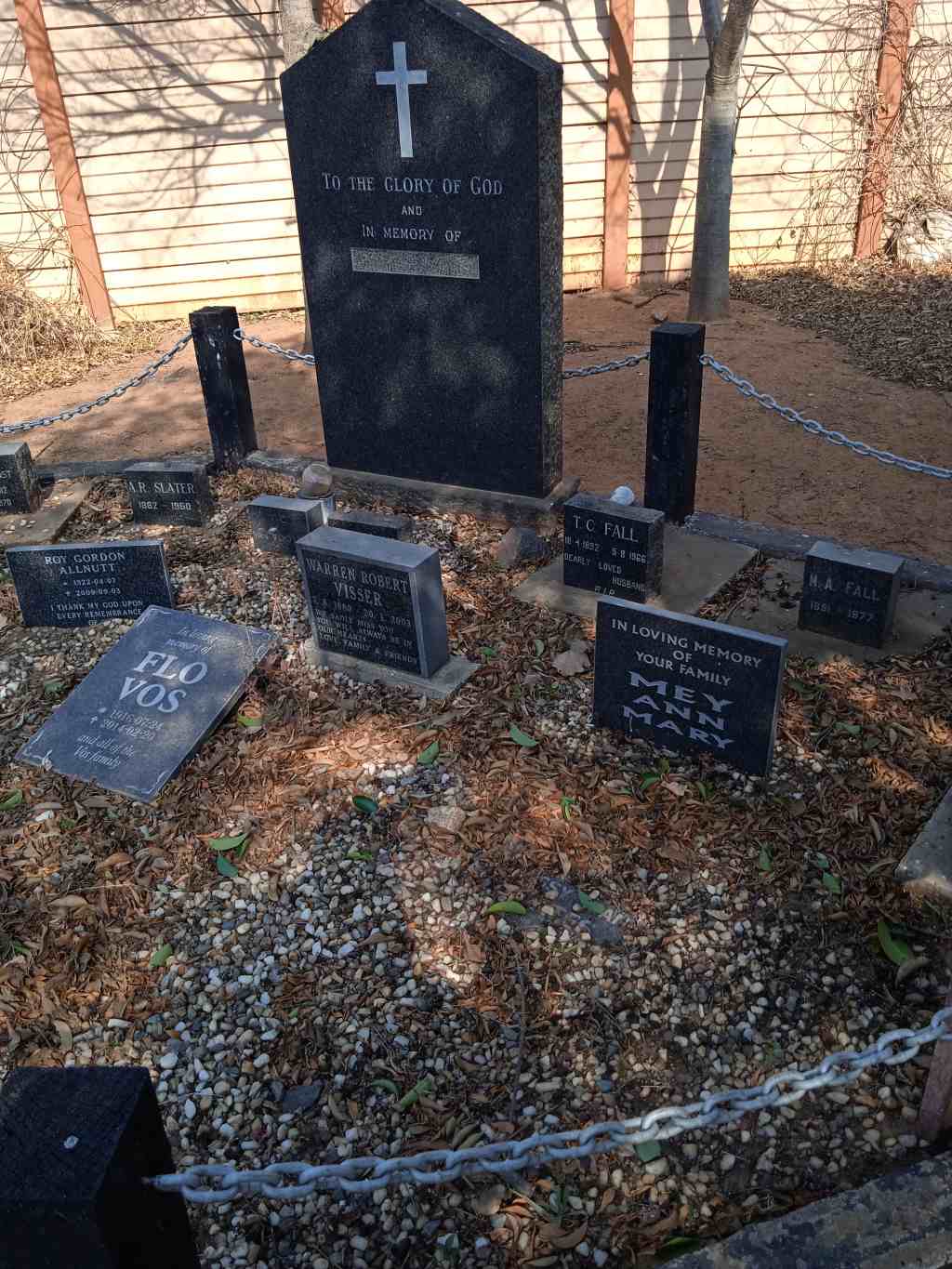 The second one is made from round wood and has the figure of the crucified Christ attached to it. It reminds me of the crucifix carried by the Catholics in front of a procession. France being predominantly catholic seems to point to this cross which came over as a war trophy. But, of course, I can be corrected. Is there any reader who is more knowledgeable in these matters then I am?
The second one is made from round wood and has the figure of the crucified Christ attached to it. It reminds me of the crucifix carried by the Catholics in front of a procession. France being predominantly catholic seems to point to this cross which came over as a war trophy. But, of course, I can be corrected. Is there any reader who is more knowledgeable in these matters then I am?
A memorial stone for T.C.Fall 18-4-1892 5-8-1966 can be found in the memorial garden of the church.
Gereformierde Kerk

 The church building is of a modern style which normaly would not interest me very much. But two reasons make it noteworthy. First the history of the congregation goes back to a time before Parys and Vredefort even existed. The congregation was formed in 1872.
The church building is of a modern style which normaly would not interest me very much. But two reasons make it noteworthy. First the history of the congregation goes back to a time before Parys and Vredefort even existed. The congregation was formed in 1872.
And the other interesting fact is the architecture of the building. It was designed by, at the time young, architect Johan de Ridder. I will be coming back to this.
The first congregation of the Gereformierte Kerk in the northern area of the Free State was established at Ventersburg in 1864. From that the congregation at Visgat ceded in 1872. Visgat was where Vredefort was later established in 1876.
One of the first deacons (ouderling) was Karel Geere, an interesting character who I have written about under Koppies.
A small church was build by the congregation in Vredefory. I have no information and have to assume that this was when the town was established between 1876 and 1880. One of the stones, sand stone, that this church was build from has been preserved at the 150 year commemorative monuments in the grounds of the church, see picture.
Because numbers were relatively low it was not possible to appoint a minister. For some years the community was served by Dirk Postma from Rustenburg and later J.L.Maury from Potchefstroom. It was only in 1918 that a call was made to have their own minister. ASE Yssel responded and was appointed.
The church in Vredefort was destroyed during the Anglo Boer war (1899-1902), only one wall was still standing. Rebuilding of the church was undertaken by the community with help from the government of R228 (I assume that means £114).
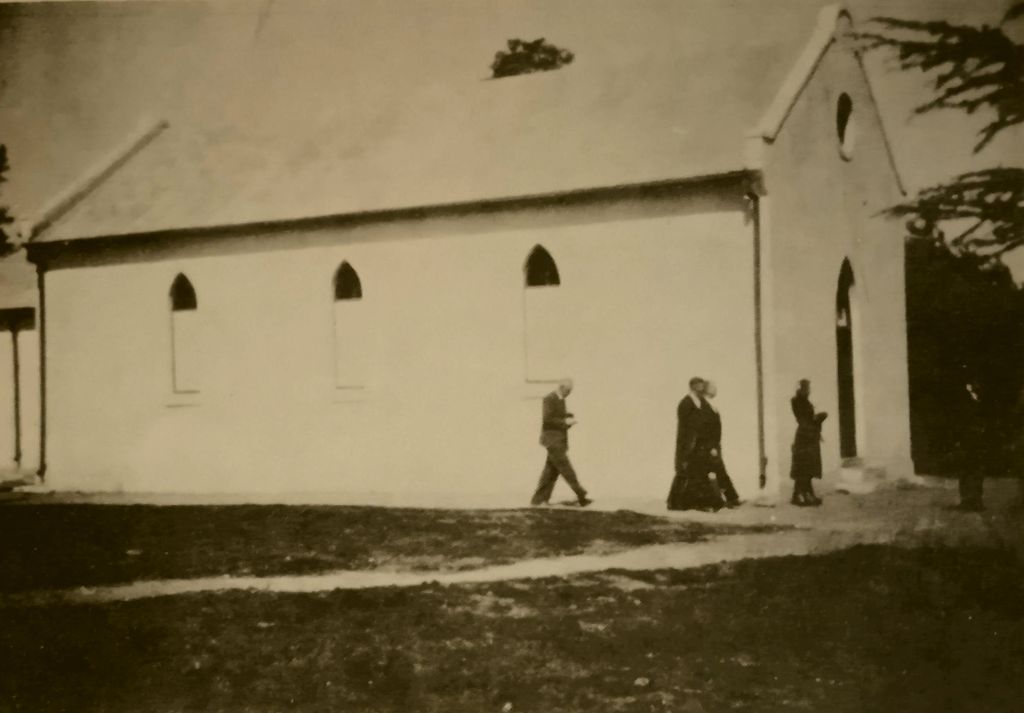 The congregation was wide spread across the towns of Vredefort, Parys, Koppies and Heilbron. Members from the outlaying areas found it difficult to attend church services on a regular basis. A program of building halls in various places was started. Parys was the first town to have a hall build at around 1925, see picture.
The congregation was wide spread across the towns of Vredefort, Parys, Koppies and Heilbron. Members from the outlaying areas found it difficult to attend church services on a regular basis. A program of building halls in various places was started. Parys was the first town to have a hall build at around 1925, see picture.
Gradually the centre of activities moved towards Parys. By 1928 there were enough members in Parys so that regular Sunday services were held. 1936 the service in Vredefort was discontinued, the minister GHJ Kruger had already moved to Parys. 1942 the church building was demolished and the stand sold.And in 1954 the decision was taken to build a new church. The old hall was demolished and Johan de Ridder appointed as the architect. The cost was R28172.
J de Ridder, at the time a very young architect, he was 27 at the time of the church design, his design set a new trend, just quoting from Wikipedia:
"The function of a church," he said to architecture students in 1955, shortly after the completion of his best known church in Parys, Free State, "is determined by public worship: it is the master builder. The building emerges from a plan and, in its turn, the plan is determined by the function of the building." In addition, he argued, there was an inherent symbolism and aesthetic in his churches suggesting the Word of God moving from the pulpit, over the congregation and, through the windows, to the world beyond. Referring to the church in Parys he said: "As in many other designs, symbolism, based on biblical truth, is embedded in this structure. It is the symbolism of the church as a tent trekking through the desert of this temporary existence on the journey towards eternity." The church is therefore a visual symbol of transience with the tent-shape a direct architectural translation of the concept of having no fixed abode.
A interesting snipet, whilst the church council was contemplating a new church building there was actually an offer from the NG church to buy their building in the center of town for R30000 plus R6000 for the organ. That offer made in 1953 was not accepted.
The Synagogue
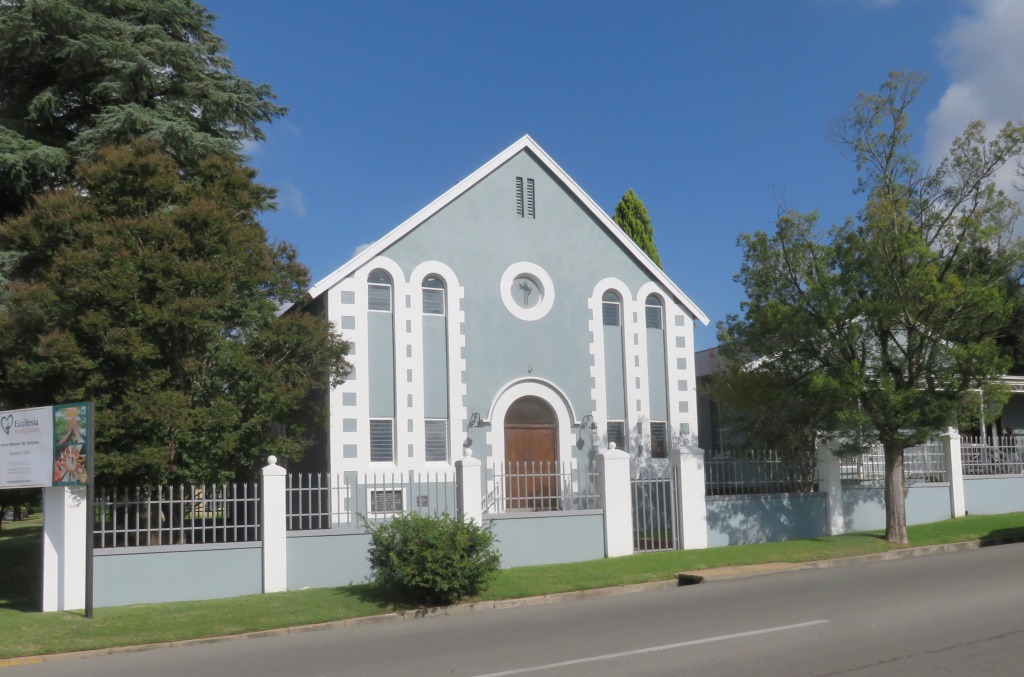
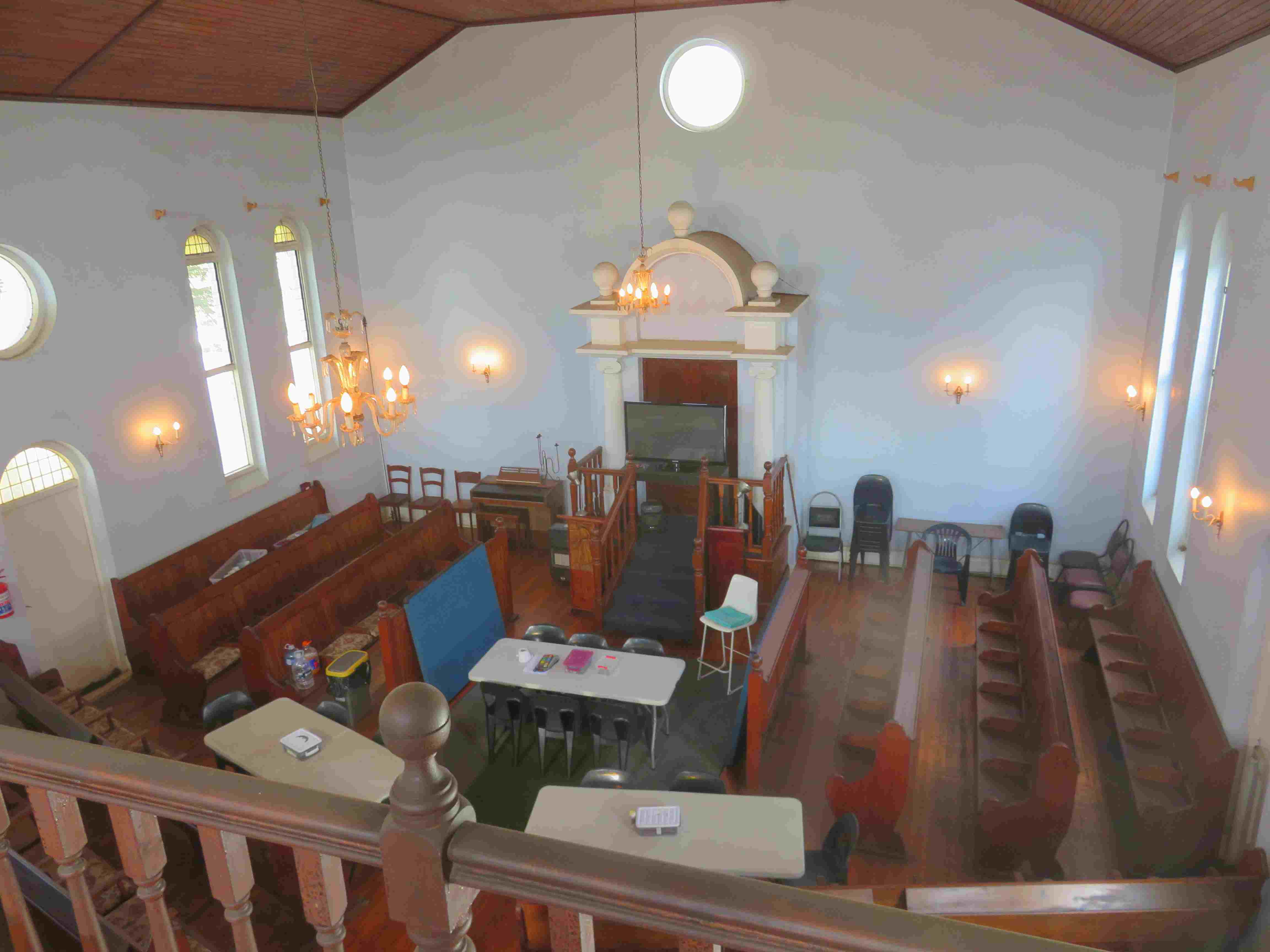 Like in most towns of the Free State, there was a Jewish community in Parys. Large enough that they could build a synagogue.
Like in most towns of the Free State, there was a Jewish community in Parys. Large enough that they could build a synagogue.
As yet, I have not found very much about the history of the jewish community in Parys. Only that the synagogue was built in 1922 and sold to the Ecclesian Christian church in 1999. It was sold with the condition that the Hebrew community could still use it for special occasions.
 The 'new' owners did not make many changes, the furniture inside, that is benches and altar is unchanged. The only change I could notice is two windows, which most likely had the David star, have been replaced with decorated windows showing the Christian cross.
The 'new' owners did not make many changes, the furniture inside, that is benches and altar is unchanged. The only change I could notice is two windows, which most likely had the David star, have been replaced with decorated windows showing the Christian cross.
 Next to the synagogue is the hall. That was built in 1951 and was then known as the Zalman Sackstein Communal Hall. It was also taken over in 1999 and is now used for the regular Sunday service.
Next to the synagogue is the hall. That was built in 1951 and was then known as the Zalman Sackstein Communal Hall. It was also taken over in 1999 and is now used for the regular Sunday service.
That the community had considerable numbers can be gauged from the Jewish section of the cemetery. I estimated that there are about 60 graves.
Cemetery
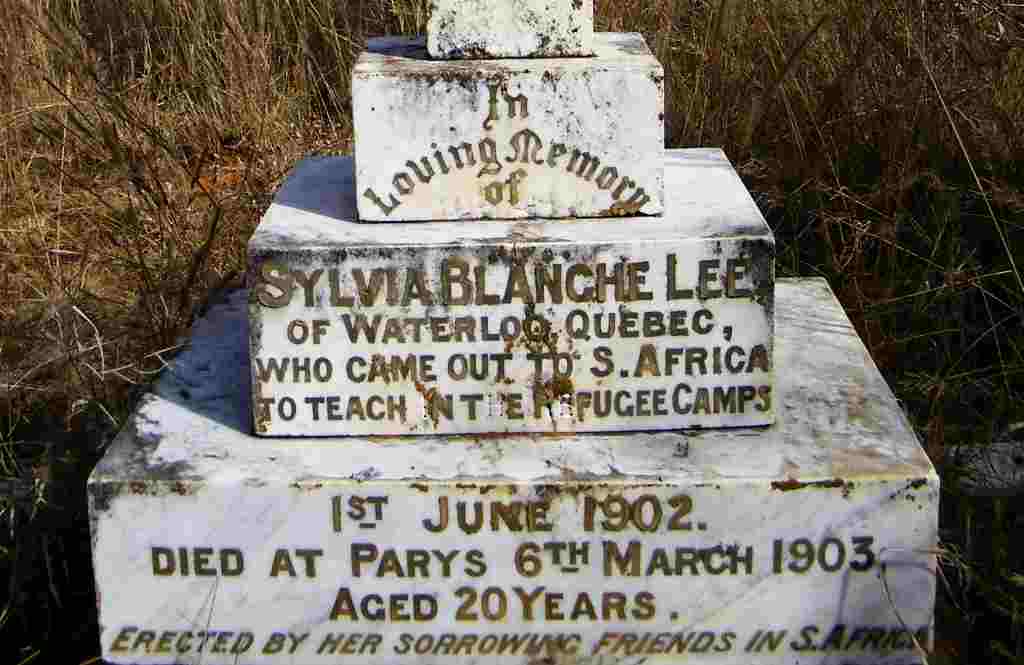 At the end of town, going out towards Vredefort, is the older of two cemeteries on the right. In the north east corner, furthest away from the gate is the oldest section of the grave yard. The original graveyard for Parys was in Buitenstreet, stand 514 which is next to the Anglican church. All the graves were transferred in the early 1960th to the cemetery above.
Here is the grave of Sylvia Blanch Lee (also one of the transferred graves), who had come out from Canada to help with the Boer War refugees. She died in Parys on the 6 March 1903. More about why she was here and what she did can be gathered from a short transcript prepared by Ria Myburgh of the Parys Museum.
At the end of town, going out towards Vredefort, is the older of two cemeteries on the right. In the north east corner, furthest away from the gate is the oldest section of the grave yard. The original graveyard for Parys was in Buitenstreet, stand 514 which is next to the Anglican church. All the graves were transferred in the early 1960th to the cemetery above.
Here is the grave of Sylvia Blanch Lee (also one of the transferred graves), who had come out from Canada to help with the Boer War refugees. She died in Parys on the 6 March 1903. More about why she was here and what she did can be gathered from a short transcript prepared by Ria Myburgh of the Parys Museum.
THE DEATH OF MISS SYLVIA LEË
(by Ria Myburgh)
The sad news of Miss Sylvia Lee’s tragic death was conveyed in a small article to her home town community in Canada, by the Waterloo Advertiser on page three of the April 11th, 1903 edition.
The article read as follows:
“The community was profoundly grieved Sunday by the sad news that Miss Sylvia Lee, who went to South Africa nearly a year ago as one of the party of Canadian teachers engaged by the British Government, had died of enteric fever at Parys, near Bloefontein.
A cablegram was received by the family on Friday, announcing that she was dangerously ill. Another cable followed the next day, saying that she had died.
 The deceased, who was in her 21st year, was the eldest daughter of Mr. and Mrs. R.W. Lee of Brandon, Manitoba and grand daughter of the late Von Arondson Lindsay, with whose family she lived from an early age.
The deceased, who was in her 21st year, was the eldest daughter of Mr. and Mrs. R.W. Lee of Brandon, Manitoba and grand daughter of the late Von Arondson Lindsay, with whose family she lived from an early age.
She was educated at Waterloo Academy and McGill Normal School. She was a successful teacher in Cookshire Academy from which she resigned in order to go to South Africa last April.
Miss Lee was a bright, clever girl, with a cheerful and amiable disposition, kind hearted and loyal to her friends and was also a general favourite. Her death comes with all the force of a personal bereavement to many friends.
A memorial service was held in St. Luke’s Church, Wednesday afternoon at three o’clock. The church was filled with a sad and sympathetic congregation. The Rev. T.B. Jenkins, who preached an appropriate discourse, was assisted in the solemn service by the Rev. James Carmichael of Koowiton, the Rev. R. Emmett of West Shefford and the Rev. Mr. Pratt of Montreal. So far as known the remains of Miss Lee will not be brought home.”
Also in this section of the cemetery is the grave of Dr.Brode, the first medical doctor who settled in Parys, and the grave of Adolf Johannes van Coller who was family of the original farm owners on which Parys was established.
P.S.: On a visit in October 2014 it was noticed that the old part of the graveyard is in an absolutely shocking state. Rubbish is being dumped there and by a number of holes dug one comes to the conclusion that grave robbers are at work here.
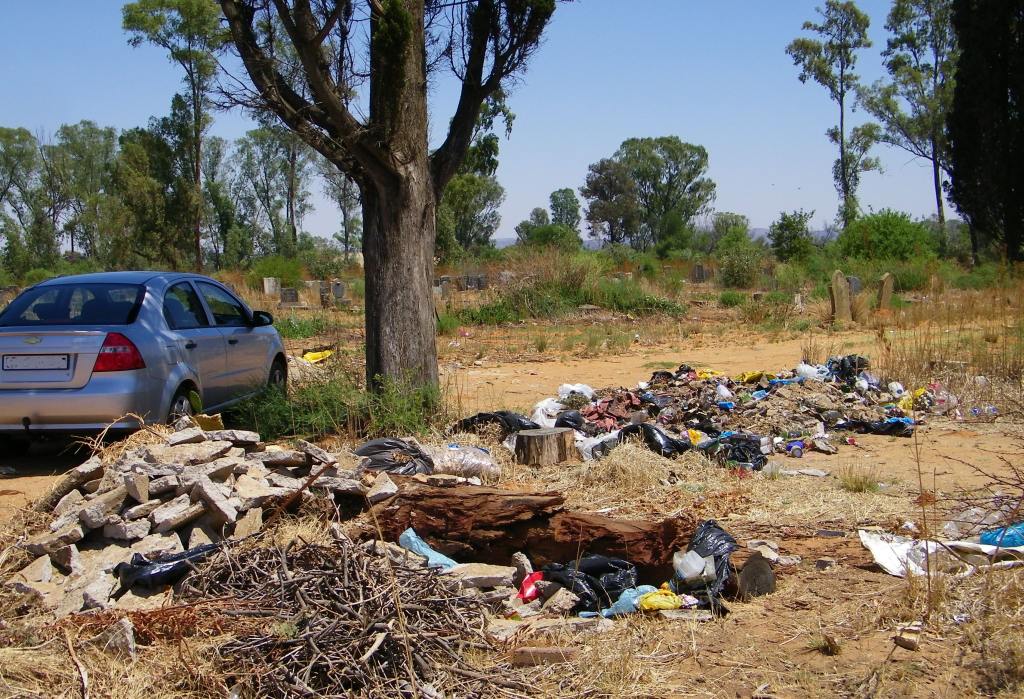
 I am trying to formulate suitable words describing how I feel about this, but cannot come up with anything printable. I am totally disgusted with the people doing this and I am also disgusted with the authorities who tolerate this and possibly are even privy to it. No respect for the dead and no respect for the environment
I am trying to formulate suitable words describing how I feel about this, but cannot come up with anything printable. I am totally disgusted with the people doing this and I am also disgusted with the authorities who tolerate this and possibly are even privy to it. No respect for the dead and no respect for the environment
Railway station
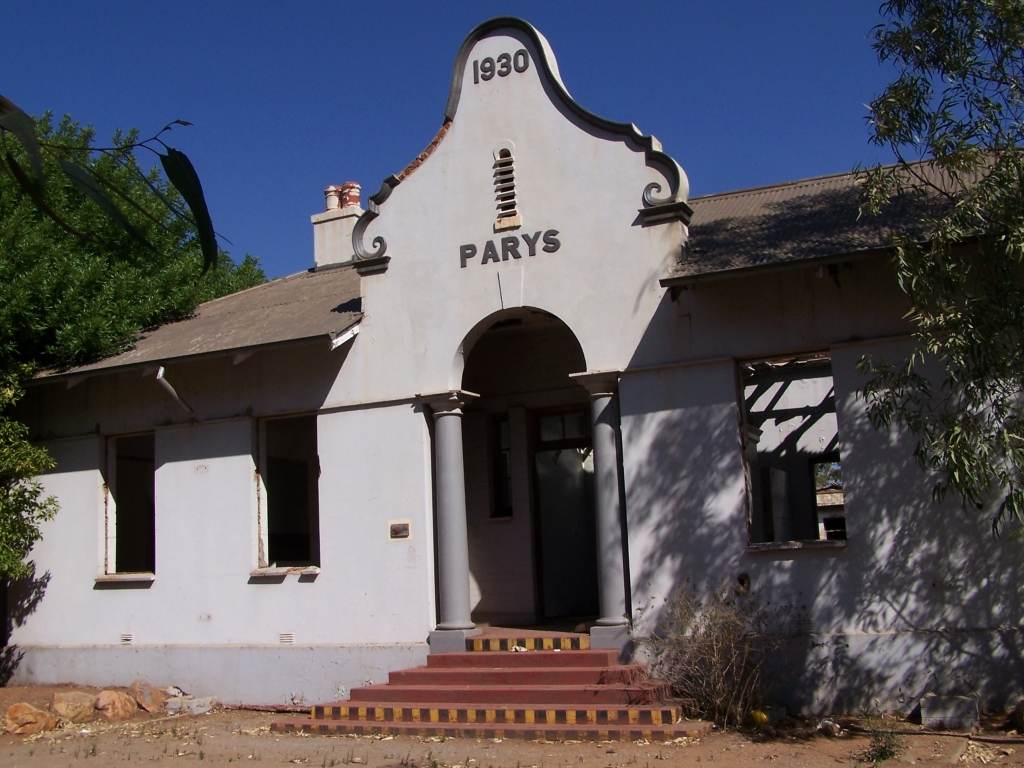 I have a fascination with old, unused rail lines and installations.
Parys also has a railway station, the trains stopped running. It was a branch line connecting Vredefort, Parys to Dover station on the main line from Vereeniging to Kroonstad. When we first got there, some years ago, the station building was a sorrow sight, no window frames, half the roof missing and full of shit (yes, literally).
I have a fascination with old, unused rail lines and installations.
Parys also has a railway station, the trains stopped running. It was a branch line connecting Vredefort, Parys to Dover station on the main line from Vereeniging to Kroonstad. When we first got there, some years ago, the station building was a sorrow sight, no window frames, half the roof missing and full of shit (yes, literally).
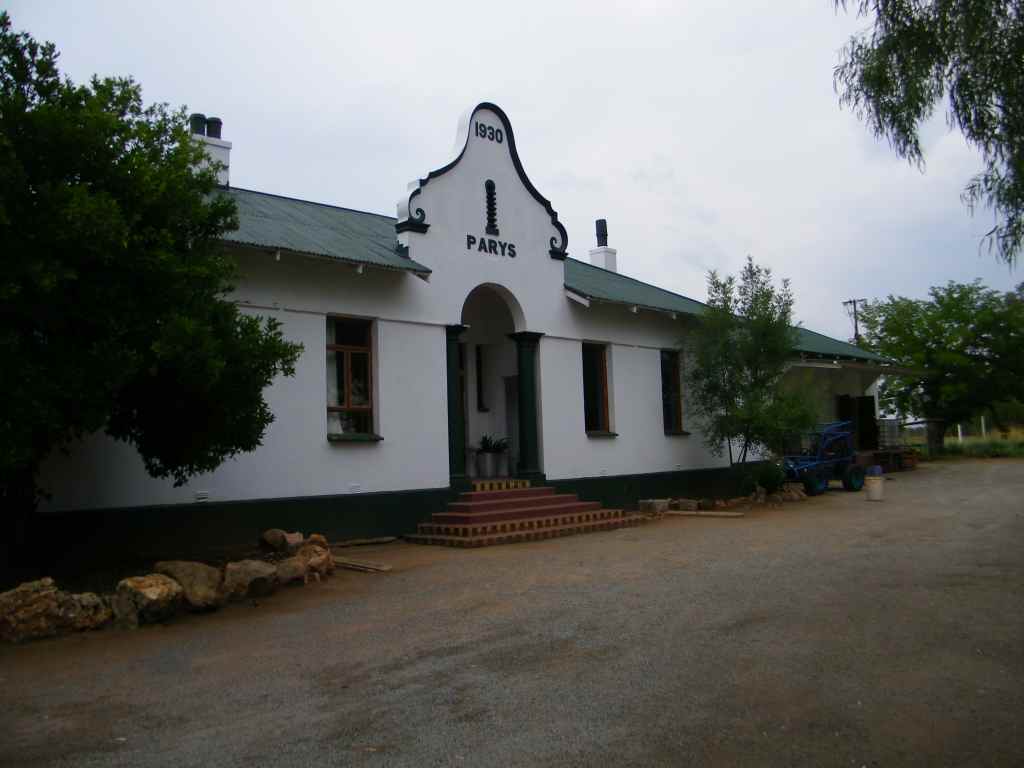 Things have changed for the better, a rail contractor has bought the building and is restoring it to its former beauty, using it as his home office. The unfortunate part is that because it is now private property there is a big fence around it. We have found this not to be a hindrance, the security guard is very accommodating and will gladly show you, the genuine tourist, around.
Things have changed for the better, a rail contractor has bought the building and is restoring it to its former beauty, using it as his home office. The unfortunate part is that because it is now private property there is a big fence around it. We have found this not to be a hindrance, the security guard is very accommodating and will gladly show you, the genuine tourist, around.
There is more about the station and the rails in redundant rails.
Parys, the holiday destination
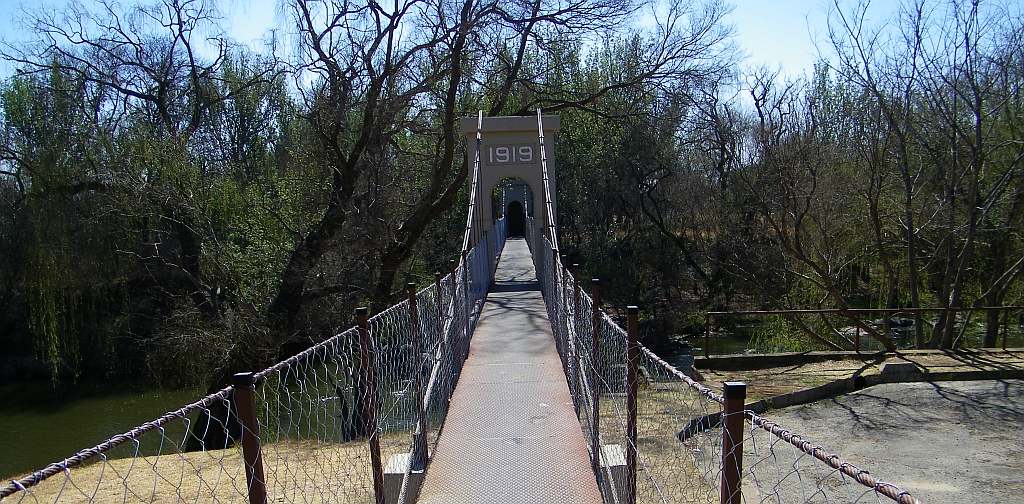 Some of the inhabitants of Parys recognised very early that with the river they had a potential holiday destination. And started projects to enhance this potential. One of the early developments was a pedestrian bridge over the channel to give access to the island. As the inscription says it was built in 1919.
Some of the inhabitants of Parys recognised very early that with the river they had a potential holiday destination. And started projects to enhance this potential. One of the early developments was a pedestrian bridge over the channel to give access to the island. As the inscription says it was built in 1919.
In my younger years I remember that we crossed 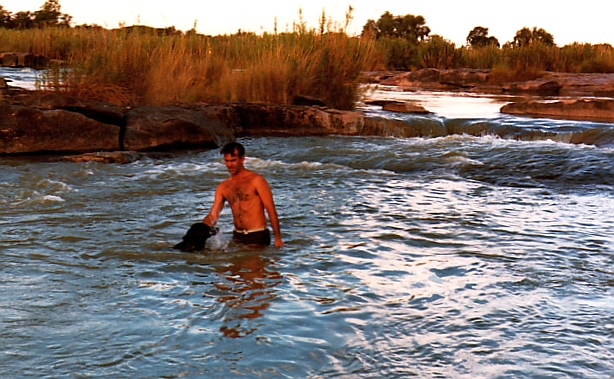 this bridge in order to occupy a picnic spot close to the river, finding places where one could swim, like in this picture showing me and the dog in about 1968.
this bridge in order to occupy a picnic spot close to the river, finding places where one could swim, like in this picture showing me and the dog in about 1968.
The bridge is not in use now, it is actually blocked off on the far end. This is because the island has been taken over by the golf club and they would not want people to take a short cut onto the fairway to play a free game. Its a pity that the island is not available any more for picnicking.
Jalalpor General Dealer

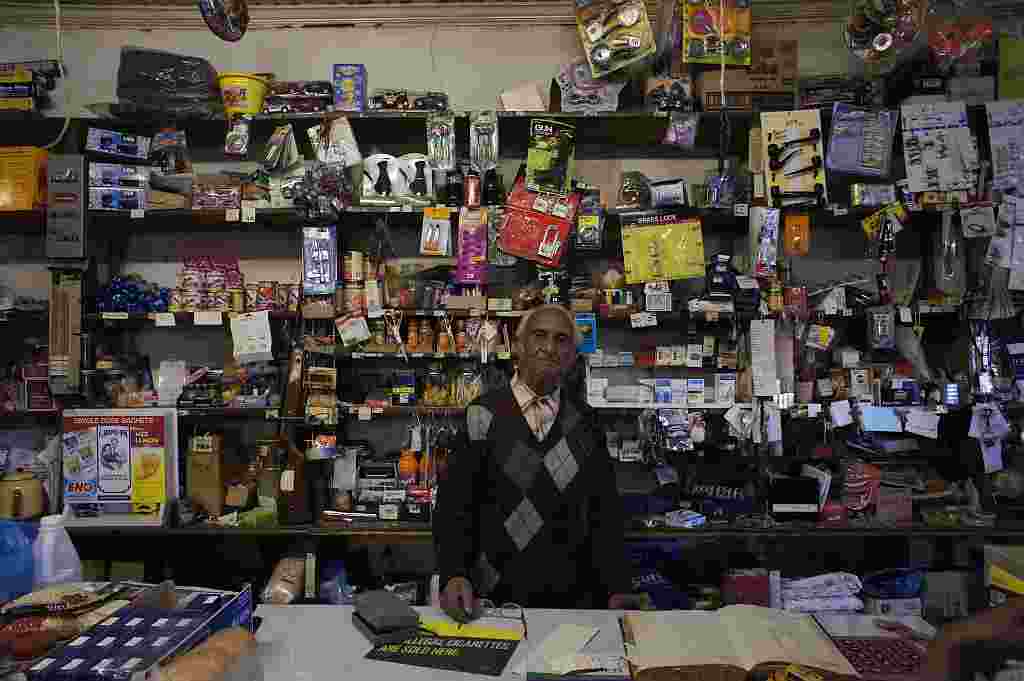 Crossing the river on the way to Potchefstroom, on the left hand side, just after the bridge, is the shop of Jalalpor General Dealer. In the old days this was a popular Indian trading store. It had to be on the 'other' side, i.e. in the Transvaal, because Indians were not allowed to trade or stay in the Orange Free State.
Crossing the river on the way to Potchefstroom, on the left hand side, just after the bridge, is the shop of Jalalpor General Dealer. In the old days this was a popular Indian trading store. It had to be on the 'other' side, i.e. in the Transvaal, because Indians were not allowed to trade or stay in the Orange Free State.
Information provided was that the building used to be the customs office to tax trade between the Free State and Transvaal (ZAR). But that can't be, since the road and the bridge were only completed in 1915. That is some years after the two states stopped existing. Before the bridge there was a drift, some distance away, at de Villier street, that road didn't come this way.
The sign over the door to the shop states 'established 1929'. But this was possibly not the beginning of this shop, read on. There was a request from the chamber of commerce to the town council in 1916 not to give permission to Indian traders to cross the river to visit the local banks or to carry out any business in Parys. This implies that there was already a trader on the other side and local business didn't like this competition. This has been confirmed by the present shopkeeper, MI Jalalpor. He told me that when his grandfather started the business in 1929 he took over an existing shop.
MI died in 1962, at that time he had three shops, one in Potchefstroom and two at the present locality, one in the building it is in at present and the other shop in the building a few meters higher up the road. Both were general dealers, only difference was that the top shop, as they called it, had a license to sell vegetables, but otherwise both shops sold the same things. Expressing bewilderment on how this could work, I was informed that this made sense in that in total it brought more customers, because shoppers like to have choices.
His son, IM Jalalpor, started working in the shop in 1948, the picture, taken in 2011, shows him proudly in his shop. During my visit then he told me how in the old days he had to get a day pass in order to go into town to do business. IM passed away in September 2014, since then his son, MI, is running the shop.
The family used the changes in the early 1990's when restrictions for Asian traders in the Free State were lifted, to establish a shop in Parys under the same name M.Jalalpor & Co.
Just a note on the name, this is actually not their family name, they are Yacoob. Jalalpor refers to the area in India where the family had come from. It is on the west coast, about 200km north of Mumbai.
Ammunition wagon explosion during the Boer War
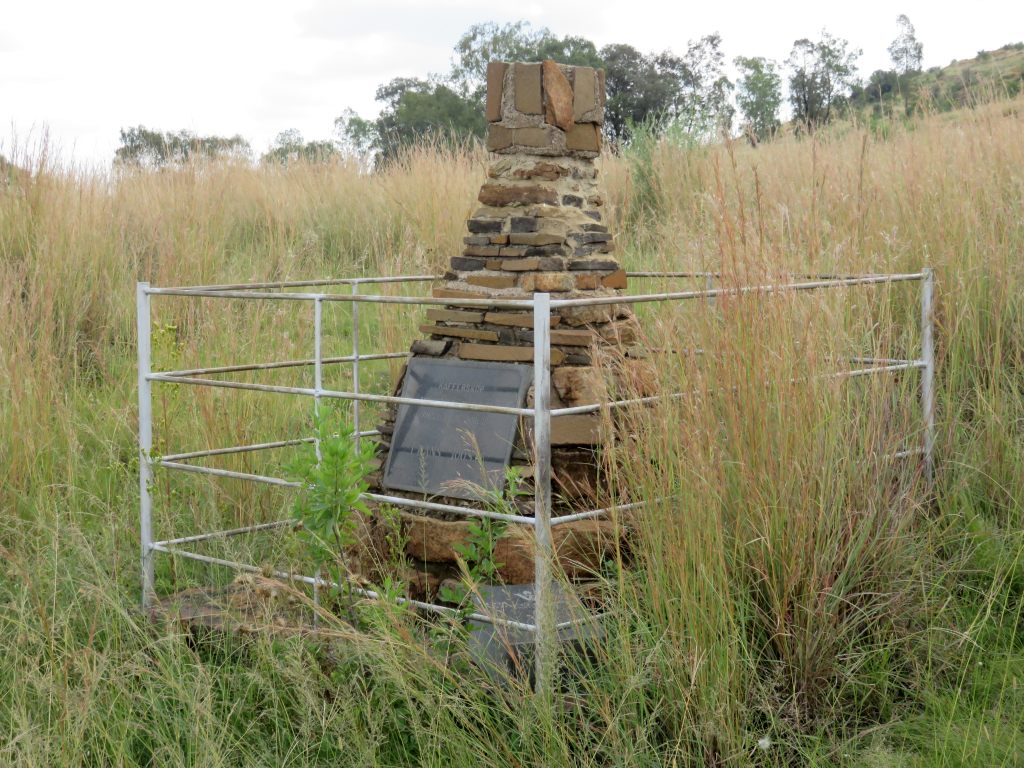
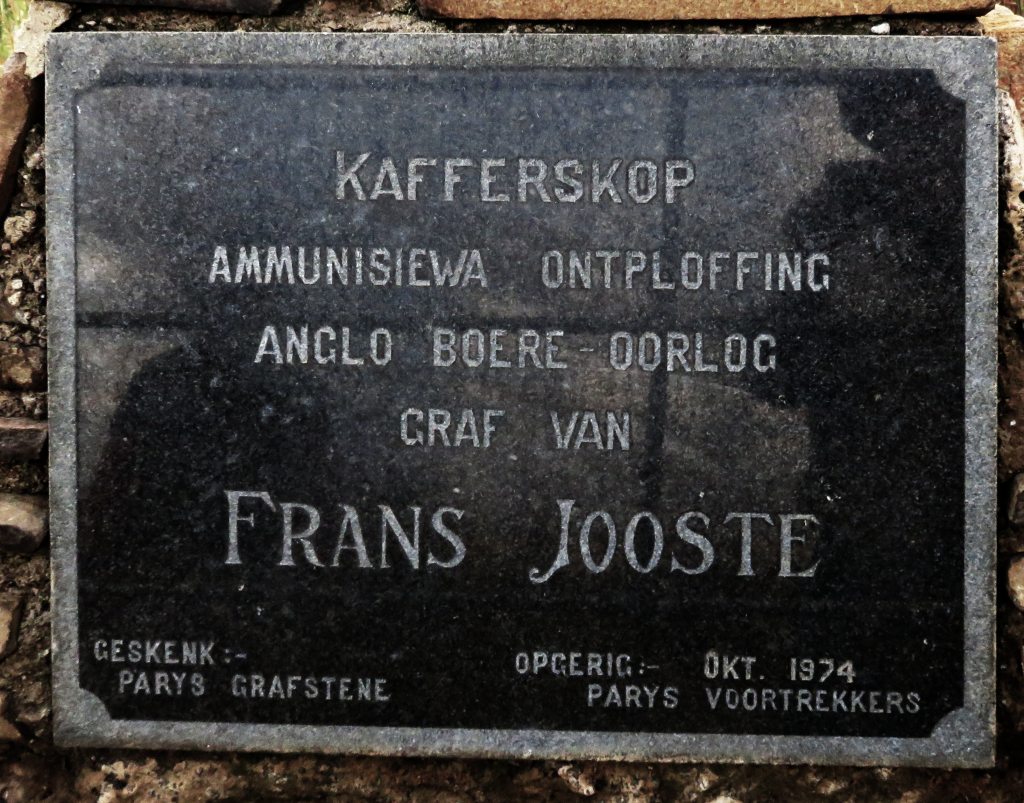 Just over the mountain from Parys towards Vredefort is a monument to the ammunition wagon explosion. It cost the life of Frans Jooste who is buried at this spot.
Just over the mountain from Parys towards Vredefort is a monument to the ammunition wagon explosion. It cost the life of Frans Jooste who is buried at this spot.
The background to this is that Christiaan de Wet, coming back from the Transvaal after fighting the battle of Frederikstad wanted to return to the Free State but found the drifts over the Vaal blocked by British troops. He had to make a run for it and managed to cross at the farm Witbank not far from Parys. In his book (Ref 2) he mentions that a wagon containing four boxes of dynamite was hit by canon fire and blew up. The drivers had before this happened already out-spanned the oxen and no other harm came about. There is an other version of the event, a transcript made available by the Parys museum describes the event in more detail. The two drivers, the Jooste brothers, abandoned the wagon when it became clear that the English were aiming for it. Nothing is said about that they out-spanned the oxen. When they were about 50 steps from the wagon Frans decided to return to fetch his jacket, at that very moment the wagon was hit and he died instantly. It is reported that the next day pieces of his body were picked up and buried in the crater made by the explosion. This is the exact point where the monument has been erected. One of the oxen was killed outright and the other one was badly injured and had run off with the remnants of the wagon.
The George Gatherer Philip Monument
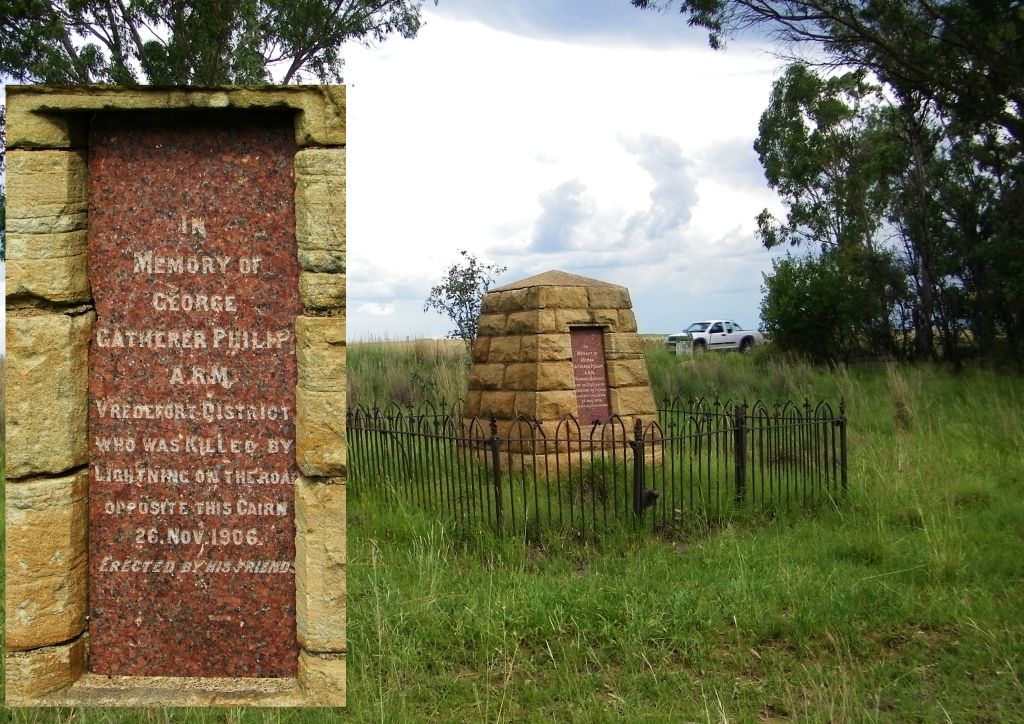 Just outside Parys, on the road to Vredefort, is a monument on the right side of the road. It has been erected by friends of GG Philips, he was hit by lightening and died on this spot on the 26-November-1906. Obviously he was popular amongst his friends for them to erect this structure. Who was GG Philips?
Just outside Parys, on the road to Vredefort, is a monument on the right side of the road. It has been erected by friends of GG Philips, he was hit by lightening and died on this spot on the 26-November-1906. Obviously he was popular amongst his friends for them to erect this structure. Who was GG Philips?
He came to South Africa with the British army during the Boer War and stayed on after hostilities had seized. He worked in Parys as a Assistant Resident Magistrate. At the time of his death at the age of 29 he was on his way from Vredefort, where he attended court, to Parys when the cart he was traveling in was hit by a bolt of lightening.
The Voortrekkers at Parys
The area around Parys was the scene of some events at the time the Voortrekkers came to the area. The first 'contact' with the Vaal tiver near Parys with the Voortrekkers was when the spear heading trek groups of Johannes van Rensburg and Louis Trichard forded the river here in April 1886. The exact place I am not certain of, it sais in the sources that they crossed at the confluence of the Vaal and the Elands river. There is a Elands spruit marked on the Military Map of the Transvaal 1881 a few kilometers upstream from Parys. Could it be that one?
Next was the trek under the leadership of Hendrik Potgieter, they had moved into the area around the present day Winburg. Here they had negotiated a deal with Makwana of the Taung people, the land between the Vaal and the Vet river was ceded to the Voortrekkers. Many trekkers took the oportunity to settle here, but some wanted to move further north (which included Hendrik Potgieter}.
A camp of trekkers under the leadership of Barend Liebenberg had been established just north of Parys near a small granite outcrop nowadays refered to as Liebenberg Koppie. An other party lead by J.Bothma and H.Steyn also had a camp on the river further downstream on the farm Kopjieskraal.
The story is well told by TV Bulpin in his book 'Lost Trails of the Transvaal'. I make it easy for myself and just quote verbatim from the book:
It was inevitable that a clash would come sooner or later between the trekkers and the maTebele. Mzilikazi, as we have seen, had never objected to the visits of small parties of Europeans, provided they secured his permission first and presented him with the expected presents and respects. Quite a stream of hunters, in fact, had journeyed up to the Transvaal of late. aptain Sutton and Lieutenant Moultrie were busy blasting away at elephants in the north-western bush veld in that very month, while a patrol from Van Rensburg and Trichardt's
trek had encountered the much-travelled Robert Schoon on the Nylstroom, returning from the north with a heavy load of ivory.
These English hunters had invariably obtained Mzilikazi's permission for their enterprises. It fell to the lot of one Stephanus Erasmus to discover what happened to gate-crashers in Mzilikazi's preserves.
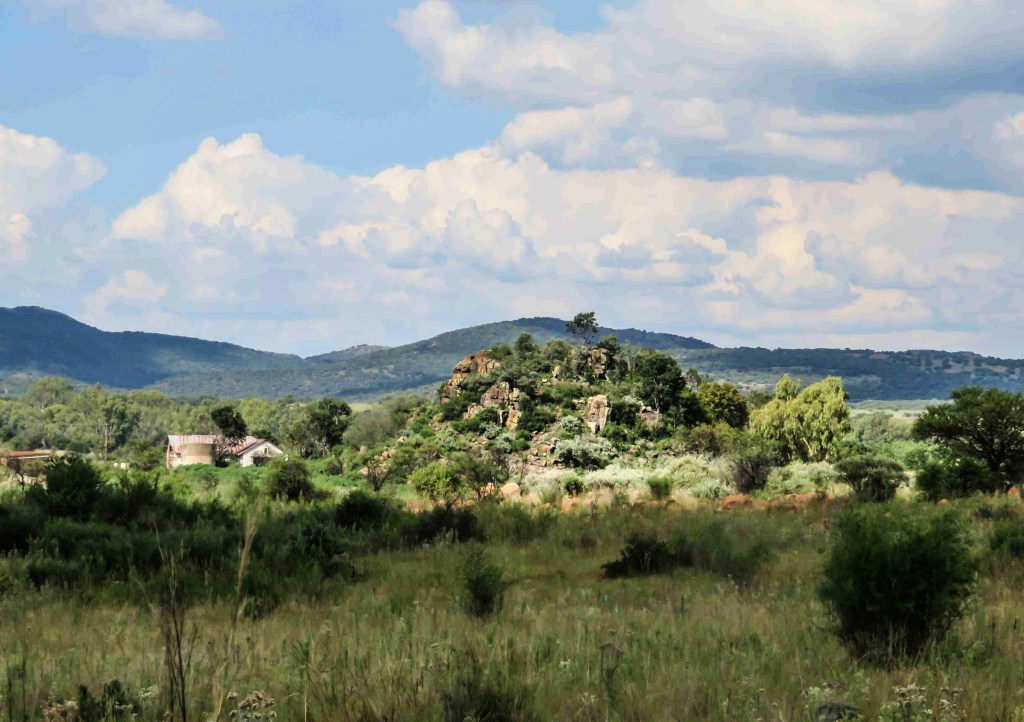 Erasmus and his party of eight Europeans, with five wagons and some Coloured servants, had journeyed up from the Cape on a hunting trip, quite independent of the trek. They visited the Khashane Mountains and were returning homewards after a not very successful hunt. Each day, while the wagons rolled slowly across the veld, the hunters scattered in search of game. On the evening of the 24th August, when Erasmus and one of his sons returned to camp, they found that they had become the hunted. Squatting around the wagons were 600 maTebele warriors, patiently waiting for the Europeans to return
Erasmus and his party of eight Europeans, with five wagons and some Coloured servants, had journeyed up from the Cape on a hunting trip, quite independent of the trek. They visited the Khashane Mountains and were returning homewards after a not very successful hunt. Each day, while the wagons rolled slowly across the veld, the hunters scattered in search of game. On the evening of the 24th August, when Erasmus and one of his sons returned to camp, they found that they had become the hunted. Squatting around the wagons were 600 maTebele warriors, patiently waiting for the Europeans to return
Erasmus and his son took one look at this spectacle and then rode for their lives. Behind them, Mzilikazi's men had already wiped out four of the European hunting party and five of their servants. The warriors waited a bit longer and then set out at a steady, loping run along the tracks of the two Erasmuses.
Five hours' ride away, late that evening, the Erasmuses reached a camp of trekkers under Barend Liebenberg, pleasantly situated among the mimosas on the north bank of the Vaal River, just opposite the present town of Parys. Erasmus warned them of the danger and then rode off to another trekker party under J. Bothma and H. Steyn, further down the river at Koppieskraal.
The Liebenberg party hardly believed the warning. They were still half heartedly preparing their laager when Mzilikazi's men reached them with a yell. Old Barend Liebenberg, his three sons, a schoolmaster named McDonald, four other Europeans, four children and twelve servants were all killed in a matter of minutes. With their loot of cattle and four European prisoners (two girls, one little Liebenberg boy, and one adult named Rudolf Bronkhorst) the maTebele turned for home.
A second section of warriors had gone towards the Koppieskraal camp. On the way they met Erasmus, leading a scouting party of eleven men. The Europeans doubled in their tracks and raced for the camp. There was hardly time to draw a wagon across the entrance of the laager before the maTebele were upon them, From I0 a.m. until 4 p.m, the warriors tried to find a way into the laager, and it was a hard six hours for the defenders.
The laager was right on the banks of the river and in a strong position. One hundred and fifty of Mzilikazi's men died trying to break in between the wagons; and of the defenders two Europeans and several of their Coloured servants were killed that day while holding the warriors at bay.
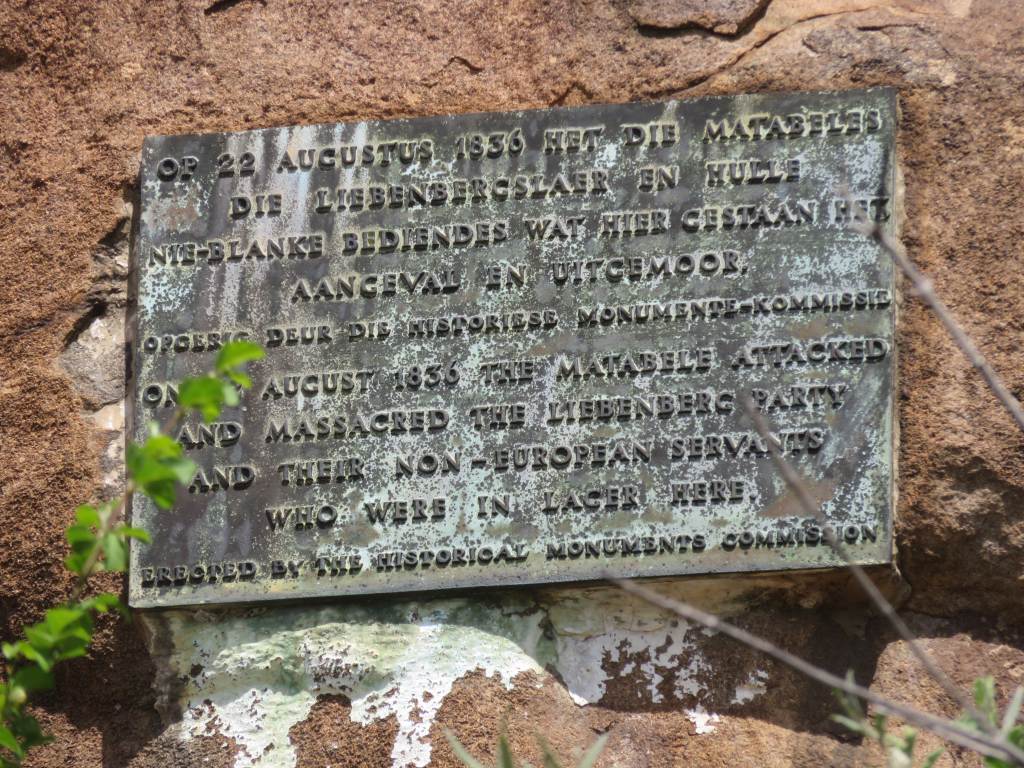 In the end the maTebele tired of the fight and withdrew to rendezvous with their fellows, leaving the trekkers like a boxer--stunned but saved by the gong. As soon as they had recovered they mustered a party to find out how the Liebenbergs had fared.
In the end the maTebele tired of the fight and withdrew to rendezvous with their fellows, leaving the trekkers like a boxer--stunned but saved by the gong. As soon as they had recovered they mustered a party to find out how the Liebenbergs had fared.
On the ride, the patrol came across the united maTebele force driving their looted livestock across the veld. The patrol fired at them, and the sharp eyes of Jacobus Hamman spotted a white child among the warriors. He raced in, shot the warrior holding the child, seized young Liebenberg, and galloped to safety with the boy across the saddle. The two little girls, however, were taken up to Mzilikazi, along with the other booty. The European male prisoner was never heard of again. The patrol rescued the wounded survivors still guarding Liebenberg's laager and took them back to Koppieskraal.
Two days later Potgieter galloped into the Koppieskraal camp. He summed up the situation and promptly ordered the survivors to fall back on the main body of the trekkers. By the 2nd September they were all back in the Free State; and there Potgieter set to work to organise defence and vengeance. Behind him, across the Vaal, lay a pile of corpses and wreckage as a memorial to the first meeting of the
Voortrekkers and Mzilikazi's warriors.
The sequence of events is described in Ref 5 somewhat differently, but the overall result is the same. It is, most likely, impossible, nearly 200 years later, to establish what exactly happened.
The sequel to this was that the trekkers moved back over the Vaal with the indention of reuniting with the Voortrekkers around Winburg. At the same time Mzilikazi organised a large force to decidedly push back the trekkers. His impis caught up with them and the trekkers being aware of the danger set up a defensive lager at Vegkop. This then was the battle of Vegkop, which I have written about.
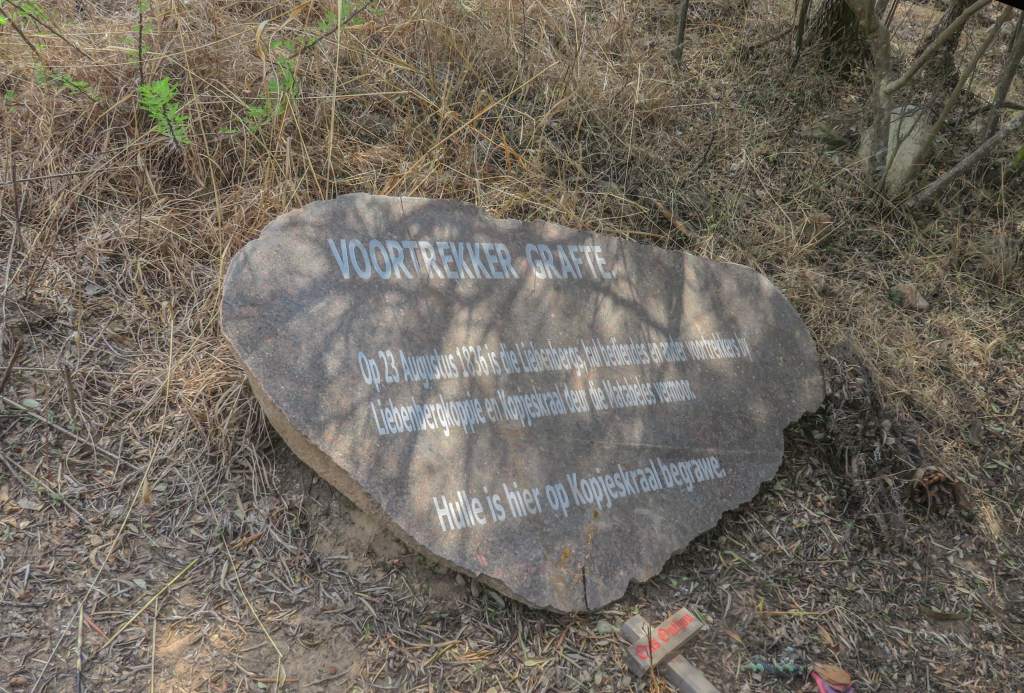
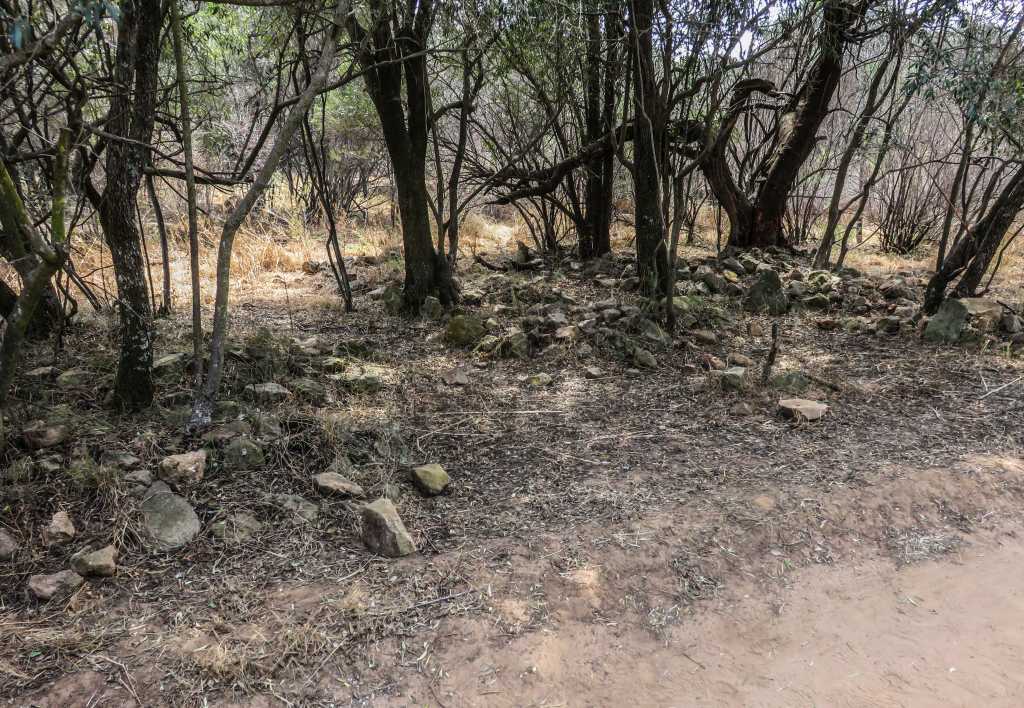 What is not very clear is what happened to the remains of the slain trekkers at Liebenberg koppies? In one of the accounts I consulted, it is said that the bodies were collected from the koppie and taken over to the camp of the 2nd group on the farm Koppieskraal. There are graves there that were known from early days as those of some Voortrekkers. Investigating this a team from the GSSA (Genealogical Society of South Africa) established this as the possible grave yard of the victims from Liebenberg Koppie. A memorial stone, obtained from the site of the murder, was cut, engraved and placed at this historical site. Just one small disagreement, these are most likely not proper graves, the ground is very rocky and digging with the tools available at the time was not possible. Thus, my opinion, the bodies were placed on the ground and covered with rocks.
What is not very clear is what happened to the remains of the slain trekkers at Liebenberg koppies? In one of the accounts I consulted, it is said that the bodies were collected from the koppie and taken over to the camp of the 2nd group on the farm Koppieskraal. There are graves there that were known from early days as those of some Voortrekkers. Investigating this a team from the GSSA (Genealogical Society of South Africa) established this as the possible grave yard of the victims from Liebenberg Koppie. A memorial stone, obtained from the site of the murder, was cut, engraved and placed at this historical site. Just one small disagreement, these are most likely not proper graves, the ground is very rocky and digging with the tools available at the time was not possible. Thus, my opinion, the bodies were placed on the ground and covered with rocks.
References:
Ref 1: 'Standard Encyclopedia of Southern Africa', 1972
Ref 2: Christiaan Rudolf de Wet,'Three Years' War', CHARLES SCRIBNER'S SONS, 1902
Ref 3: 'Ons Kerk Album van Hollandsche Kerken en Leeraren', publisher: unknown, printed 1917
Ref 3: Johan H.van Eeden, 'Parys 1876--1976'
Ref 4: T.V.Bulpin, 'Lost Trails of the Transvaal', Thomas Nelson and Sons, 1965
Ref 5: John Laband, 'The Boer Invasion of the Zulu Kingdom 1837-1840', Jonathan Ball Publishers, 2022, ISBN 978-1-77619-270-0
Ref 6.: GBA Gerdener, Sarel Cilliers - die Vader van Dingaansdag, 1919